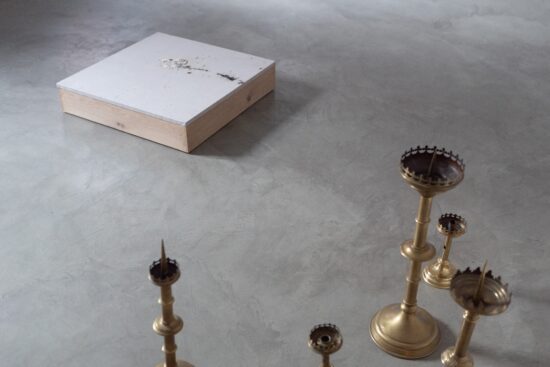Dainius Liškevičius

Dainius Liškevičius, Linking to the Place, exhibition fragment, 2020. Photo Laurynas Skeisgiela
Dainius Liškevičius (born 1970) belongs to the middle generation of artists who conceptualised the notion of sculptural object and installation in the Lithuanian art scene. Over many years, he has developed complex installation projects of an archival nature. The first such project was ‘Museum’, first exhibited in 2012. Here the artist experimented with alternatives to the traditional construction of museum exhibitions by creating several parallel narratives. Real historical figures and objective events appeared together with Liškevičius’s personal and creative stories, and subjective memories, all based around an openly subjective selection of exhibits. In another project entitled ‘Labyrinthus’ (2014), Liškevičius used the same method of conceptually and associatively grouping a variety of objects from his extensive collection in order to explore how scientific, pseudo-scientific, and religious theories function in parallel.
In his latest works, the artist returns to adopting a more direct form of expression, resembling his early work. In his performance ‘Entropy / Che fare?’ (2018), the structure of a labyrinth or museum is superseded by a chaotic confluence of ideas, which is then overpowered by dystopic noise. The latter is generated both by voice and seemingly unrelated objects among which there is a vertical box with the eyes of a woman, piercing the viewer in a way that only simple but unanswerable questions can do. In the project ‘ABC / Kinetic Transformation of a Monument’ (2019), which was exhibited with other satirical proposals for the reconstruction of a controversial monument to Petras Cvirka in Vilnius, the artist seems to return to his pop-provocative roots – his proposal features a machine installed under the sculpture that enables it to remain hidden inside the pedestal, only rising up into view when a viewer inserts a coin.
Dainius Liškevičius completed his postgraduate art studies at the Vilnius Academy of Arts in 2012. In 2015, he represented Lithuania at the 56th International Venice Biennale with his project ‘Museum’. He has had solo exhibitions at the National Gallery of Art and the Contemporary Art Centre in Vilnius, Galerie für Zeitgenössische Kunst in Leipzig, and Galeria Foksal in Warsaw. He has participated in group shows at the Kumu Art Museum in Tallinn, Bunkier Sztuki Gallery in Kraków, and Artspace in Sydney.